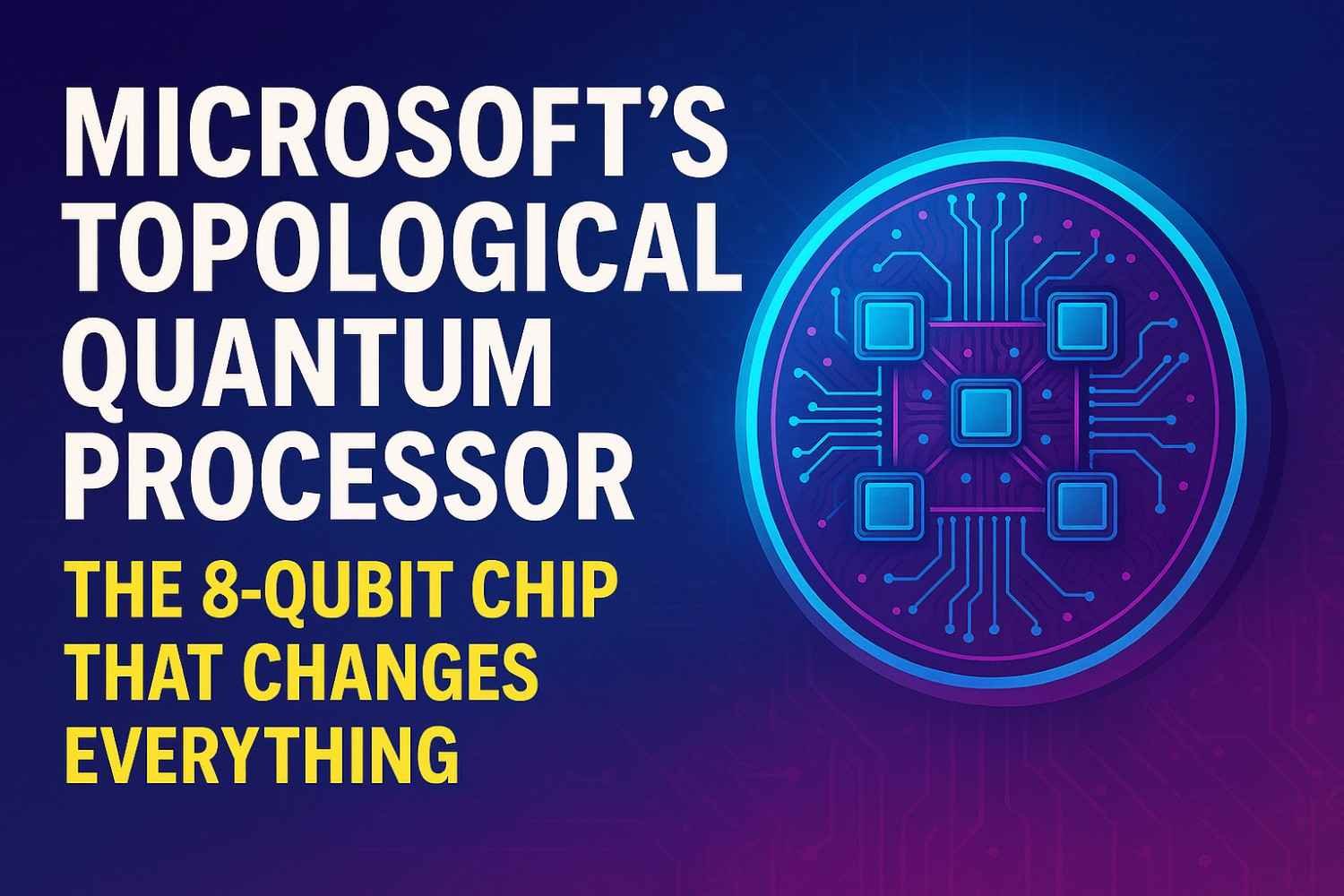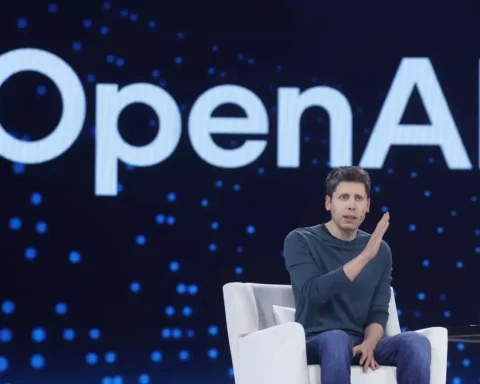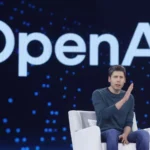In a groundbreaking development that could fundamentally alter the trajectory of quantum computing, Microsoft unveiled Majorana 1, the world’s first 8-qubit topological quantum processor, at their Station Q conference in February 2025. This revolutionary achievement represents the culmination of decades of theoretical physics research and marks a pivotal moment in the quest for fault-tolerant quantum computing. Unlike conventional quantum computers that struggle with error rates and stability, Microsoft’s topological approach promises inherently protected quantum information that could finally make quantum computing practical for real-world applications.
The Topological Quantum Computing Breakthrough
Topological quantum computing represents a fundamentally different approach to quantum information processing, one that Microsoft has pursued relentlessly despite skepticism from competitors focused on more conventional quantum architectures. The breakthrough centers on exotic particles called Majorana zero modes—theoretical entities predicted by Italian physicist Ettore Majorana in 1937 that are their own antiparticles and possess unique quantum properties ideal for protected quantum computation.
The Majorana 1 processor demonstrates practical implementation of these theoretical concepts, creating a new state of matter called a topological superconductor that hosts Majorana zero modes at specific boundaries. These particles naturally resist the environmental disturbances that plague conventional qubits, potentially solving quantum computing’s most persistent challenge—maintaining quantum coherence long enough to perform useful calculations.
Microsoft’s approach differs radically from superconducting qubits used by IBM and Google or trapped ions employed by companies like IonQ. Instead of fighting quantum decoherence through complex error correction schemes requiring hundreds or thousands of physical qubits to create single logical qubits, topological qubits embed error protection directly into their physical structure.
This hardware-level error protection could enable quantum computers with dramatically fewer physical qubits to achieve fault-tolerant quantum computing—the holy grail that would allow quantum systems to outperform classical computers on practical problems while maintaining reliability comparable to conventional computing systems.
Technical Architecture and Innovation
The Majorana 1 processor leverages semiconductor heterostructures—layered materials with precisely controlled properties—developed through collaboration between Microsoft Station Q and UC Santa Barbara researchers. These structures create the exotic quantum states necessary for hosting Majorana zero modes while providing the control mechanisms needed for quantum computation.
The eight-qubit configuration may seem modest compared to IBM’s 1000+ qubit processors or Google’s quantum supremacy demonstrations, but topological qubits operate under fundamentally different performance metrics. Each topological qubit potentially provides the computational power of dozens or hundreds of conventional qubits due to their inherent error protection and extended coherence times.
Quantum information in topological systems is stored non-locally, distributed across the entire physical system rather than localized in individual particles or atoms. This distribution makes the information extraordinarily robust against local disturbances that would destroy quantum states in conventional architectures, enabling quantum computations to proceed for extended periods without accumulation of errors.
The control systems for topological qubits also differ significantly from conventional approaches. Rather than requiring precise microwave pulses and magnetic field control like superconducting qubits, topological quantum gates operate through physical manipulation of Majorana modes using electrical signals, potentially simplifying both control electronics and operational requirements.
Implications for Quantum Computing Scalability
Microsoft’s roadmap envisions scaling topological quantum processors to one million qubits—a target that seems impossible with conventional quantum architectures due to error accumulation and control complexity. Topological qubits’ inherent error protection could make such scaling feasible by eliminating the massive overhead required for quantum error correction in conventional systems.
The scalability advantages extend beyond pure qubit count to operational simplicity. Topological quantum computers could potentially operate at higher temperatures than current quantum systems, reducing the extreme cooling requirements that make current quantum computers expensive and complex to maintain. This temperature tolerance stems from the topological protection mechanism that shields quantum information from thermal disturbances.
Manufacturing scalability also benefits from topological approaches that leverage semiconductor processing techniques similar to conventional electronics fabrication. This compatibility with existing manufacturing infrastructure could enable mass production of topological quantum processors using modified versions of current semiconductor facilities, dramatically reducing production costs compared to specialized quantum manufacturing approaches.
Collaborative Research and Academic Partnerships
The Majorana 1 breakthrough reflects extensive collaboration between Microsoft Station Q and UC Santa Barbara researchers, particularly leveraging expertise from the late Nobel laureate Herb Kroemer’s semiconductor heterostructure concepts. This academic-industry partnership exemplifies the interdisciplinary collaboration necessary for quantum computing breakthroughs that span theoretical physics, materials science, and engineering.
Chris Palmstrøm’s contributions to semiconductor materials development and Susanne Stemmer’s fabrication process expertise proved crucial for creating the precise material structures required for hosting Majorana zero modes. The collaboration also benefits from UC Santa Barbara’s broader quantum research ecosystem, including faculty and students who contribute to both fundamental research and practical implementation challenges.
Microsoft’s hiring of numerous students and researchers from these academic partnerships creates knowledge transfer pathways that accelerate both fundamental understanding and practical development of topological quantum technologies. This talent pipeline ensures continued innovation while building the specialized workforce necessary for scaling topological quantum computing.
The research collaboration extends internationally, with Microsoft Station Q maintaining partnerships with quantum research institutions worldwide. This global network provides access to diverse expertise and experimental capabilities while contributing to the fundamental science underlying topological quantum computing.
Computer science and physics programs worldwide are establishing curricula focused on topological quantum computing concepts, requiring comprehensive educational resources that explain complex quantum phenomena and their practical implementations. Universities developing quantum computing programs often need detailed technical presentations, expert lectures, and laboratory demonstrations to effectively teach these advanced concepts. For academic institutions building topological quantum computing curricula, accessing educational content through reliable free online youtube video downloader services enables offline study of complex theoretical concepts and experimental demonstrations essential for understanding this revolutionary quantum computing approach.
Competitive Landscape and Strategic Positioning
Microsoft’s topological quantum computing strategy represents a high-risk, high-reward approach that could leapfrog competitors if successful while risking technological irrelevance if the approach proves impractical. Major competitors like IBM, Google, and Amazon have invested heavily in conventional quantum architectures with demonstrated but limited capabilities, while Microsoft pursued the more challenging but potentially transformative topological approach.
The Majorana 1 demonstration validates Microsoft’s long-term strategy and could attract significant industry attention and investment in topological approaches. Success could trigger shifts in competitors’ research priorities as they evaluate whether topological advantages justify pivoting from established quantum architectures with known limitations.
Patent landscapes around topological quantum computing favor Microsoft due to their early and sustained investment in the field. This intellectual property position could provide significant competitive advantages as topological quantum computing matures toward commercial applications, potentially creating licensing opportunities and market barriers for competitors.
The timing of Microsoft’s breakthrough coincides with growing industry recognition that current quantum computing approaches face fundamental scalability challenges. Topological quantum computing could provide solutions to these limitations, positioning Microsoft as a leader in the next generation of quantum technologies.
Commercial Applications and Market Potential
Topological quantum computers’ inherent fault tolerance makes them particularly suitable for commercial applications requiring high reliability and extended computation times. Financial modeling, optimization problems, and scientific simulations could benefit immediately from topological quantum capabilities without waiting for the massive error correction overhead required by conventional quantum systems.
Microsoft’s integration with Azure cloud services positions topological quantum computers for widespread commercial access through cloud-based quantum computing services. This delivery model could enable organizations to access quantum capabilities without investing in quantum hardware infrastructure, accelerating adoption across industries.
Drug discovery and materials science applications represent particularly promising markets for topological quantum computing due to their tolerance for longer computation times and requirement for high-accuracy results. These applications could generate substantial commercial value while demonstrating topological quantum computing’s practical advantages over classical approaches.
The automotive and aerospace industries show significant interest in quantum optimization capabilities for supply chain management, route planning, and design optimization. Topological quantum computers’ reliability could make them suitable for mission-critical applications where quantum computation errors would have severe consequences.
Technical Challenges and Development Timeline
Despite the breakthrough demonstration, significant technical challenges remain before topological quantum computers achieve practical utility for commercial applications. Scaling from eight qubits to the hundreds or thousands required for quantum advantage requires continued advances in materials science, fabrication techniques, and control systems.
Quantum gate fidelity and operation speed require optimization to achieve performance levels necessary for practical quantum algorithms. While topological protection provides inherent error resistance, achieving the precise control required for complex quantum computations demands continued refinement of operational techniques and control electronics.
Software development for topological quantum computers requires new programming paradigms and development tools adapted to the unique characteristics of topological qubits. This software ecosystem development could take years and requires coordination between quantum software developers and hardware specialists.
Manufacturing consistency represents another critical challenge as topological quantum processors transition from laboratory demonstrations to commercial production. The precision required for creating stable Majorana zero modes demands manufacturing processes with tolerances exceeding current semiconductor industry standards.
Integration with Classical Computing Systems
Topological quantum processors will likely operate as specialized accelerators within hybrid classical-quantum computing systems rather than standalone quantum computers. This integration requires sophisticated interfaces between classical control systems and quantum processors, along with software frameworks that seamlessly distribute computations between classical and quantum processing elements.
Microsoft’s quantum development kit and Q# programming language provide foundations for this integration, but additional development is required to optimize hybrid algorithm performance and minimize classical-quantum communication overhead. The unique characteristics of topological qubits may require specialized programming approaches that differ from conventional quantum programming paradigms.
Real-time classical processing for quantum error monitoring and correction, while reduced for topological systems, still requires high-performance classical computing capabilities integrated closely with quantum processors. This integration complexity represents both a technical challenge and a potential competitive advantage for companies with expertise in both classical and quantum computing systems.
Future Research Directions and Innovation
Microsoft’s roadmap includes scaling topological quantum processors through improved fabrication techniques and novel materials that enhance Majorana zero mode stability and controllability. Research continues into alternative topological superconductor materials that could provide improved performance characteristics or simplified manufacturing requirements.
Advanced topological quantum architectures under development could provide enhanced connectivity between qubits and support for more complex quantum algorithms. These architectural improvements could enable topological quantum computers to tackle broader ranges of computational problems while maintaining their inherent error resistance advantages.
Integration with other quantum technologies, including quantum sensing and quantum communication systems, could create comprehensive quantum information processing platforms that leverage topological protection across multiple quantum applications. This convergence could accelerate quantum technology adoption by providing integrated solutions for diverse quantum computing needs.
Investment and Commercialization Strategies
Microsoft’s substantial investment in topological quantum computing reflects confidence in the technology’s commercial potential despite the longer development timeline compared to conventional quantum approaches. The company’s ability to sustain this investment through the extended research and development period demonstrates the strategic importance Microsoft places on quantum computing leadership.
Venture capital and government funding for topological quantum computing research has increased following Microsoft’s demonstration, indicating growing confidence in the approach’s viability. This funding supports academic research and startup companies developing complementary technologies for topological quantum systems.
Commercial partnerships with organizations requiring high-reliability quantum computing could provide early revenue opportunities while driving continued development of topological quantum technologies. Industries with stringent reliability requirements may prefer topological approaches despite potentially lower initial performance compared to conventional quantum systems.
Global Impact and Technology Transfer
Microsoft’s topological quantum computing breakthrough could influence international quantum computing strategies as governments and companies reassess their quantum technology investments. Countries with limited quantum computing capabilities might prioritize topological approaches as potentially more achievable paths to quantum advantage.
Technology transfer opportunities include licensing topological quantum technologies to academic institutions and companies developing specialized quantum applications. Microsoft’s patent portfolio could generate significant licensing revenue while accelerating global adoption of topological quantum computing concepts.
Educational initiatives to train researchers and engineers in topological quantum computing principles could help build the global workforce necessary for scaling this technology. Microsoft’s collaboration with universities provides models for knowledge transfer that could be replicated internationally.
Conclusion
Microsoft’s Majorana 1 topological quantum processor represents a watershed moment in quantum computing development, validating decades of theoretical research while demonstrating practical pathways toward fault-tolerant quantum computing. The eight-qubit demonstration may seem modest, but the underlying topological protection principles could enable quantum computers that finally deliver on the technology’s transformative promises.
The success of topological quantum computing depends on continued advances in materials science, fabrication techniques, and quantum control systems, along with development of software ecosystems that enable practical applications. Microsoft’s sustained investment and collaborative approach with academic partners provide strong foundations for continued progress toward commercial topological quantum systems.
The broader implications extend beyond Microsoft’s competitive position to potentially reshape the entire quantum computing industry. If topological approaches prove superior for practical quantum computing applications, the massive investments in conventional quantum architectures by competitors could require fundamental strategic reassessment.
As 2025 progresses and Microsoft continues developing topological quantum technologies, the quantum computing industry will closely monitor whether inherent quantum protection proves superior to brute-force error correction approaches. The outcome could determine which quantum computing paradigm dominates the emerging quantum economy and shapes humanity’s computational future.













